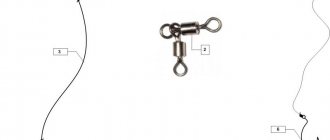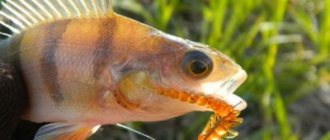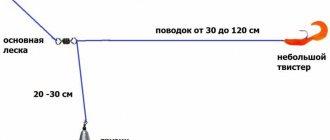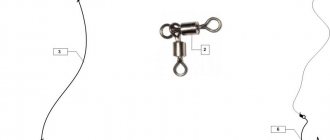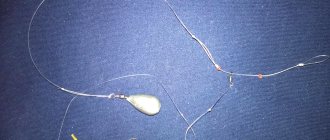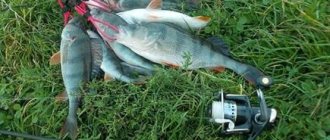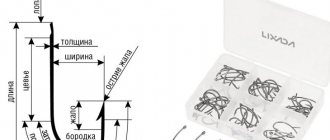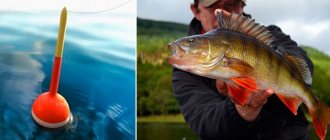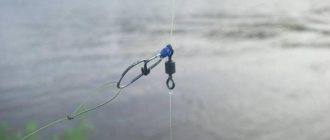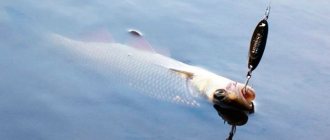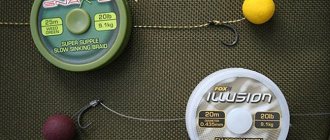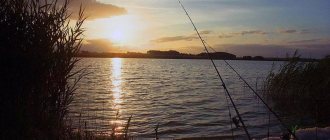RnR: Andrey, which bodies of water, in your opinion, are the most promising for catching pike perch?
A.P.: First of all, large bodies of water are best suited for systematic fishing of pike perch: large rivers (Oka in the middle and lower reaches, Volga, Akhtuba...), large reservoirs (in the Moscow region: Ozerninskoye, Ruzskoye, Ivankovskoye...). It is in large reservoirs that the population of pike perch is maximum.
At the same time, pike perch are also present on some small rivers. Let’s say the width of the river is 40–60 m, there is pike perch in it, but, as a rule, catching it here is sporadic, that is, during fishing you can catch 1–2 fish weighing usually no more than 2 kg. Larger specimens are extremely rare on such rivers. But on large bodies of water, a 2-kilogram pike perch is far from the limit. That is, generally speaking, pike perch is a big water fish...
RnR: What methods of catching pike perch are most effective?
A.P.: It will be most convenient to divide the baits along the fishing horizon.
Pike perch fishing depths are up to 1 m. Most often, it is possible to catch pike perch at such depths at dusk and at night. This is a common phenomenon for rivers, for example, the middle and lower reaches of the Oka. The most effective bait in this situation will be a shallow-water minnow wobbler.
The depths for fishing for pike perch are from 1 to 3.5 m. In this case, deep-sea wobblers, a light jig and a retractable leash are optimal. One of the most effective baits is deep wobblers. The fisherman’s task is to select a wobbler that will go as close to the bottom as possible (it is in this layer that the active predator runs).
During the current, a diverting leash also shows good results. The only thing that can discourage you from using it at a relatively shallow depth is a large number of large stones. It is unlikely that the weight will be caught in such a place, so the most profitable bait in this situation will again be a deep wobbler.
But if the bottom in the fishing area is more or less flat (without large boulders), you can successfully use a pull-out or jig. What exactly is better depends on the specific location. But the general pattern is this: if there is a current, then the use of a diverting leash will be most effective, and in places without a current (for example, on reservoirs), the pike perch gravitates more towards a light jig - it really likes the vertical component in the wiring!
The fishing depth for pike perch is more than 3.5 m. This is the kingdom of jig and retractable leash. Again, this pattern is repeated here over time. If there is one, it’s better to use a diverter; in still water, use a jig. This is exactly what we should start from.
Types of rigs with a retractable leash
A rig using a leash is one in which the sinker is not mounted to the hook, like a jig head or shank, but is placed either directly on the leash itself, in front of or behind the bait, or on the central line, or on an auxiliary leash.
The same equipment can have a lot of options, most of which use an offset hook. Along with it, it is possible to use doubles and tees. Offset is preferable if fishing is carried out in snagged areas of the reservoir.
There are a wide variety of offsets. The most widely used hooks are those with a wide hook. Models are often practiced where a weight is soldered onto the fore-end, in its lower part. Their disadvantage is that the diameter of the hook ring is critically small, and it is very difficult to pass the winding ring through it.
Texas rig
Texas is a combination of silicone strung on an offset or single hook and a load moving along a central line. The weight is bullet-shaped, thanks to which the tackle easily slides through aquatic vegetation.
Why fishermen prefer to mount Texas equipment:
- ease of assembly;
- excellent maneuverability in hard-to-reach places;
- catchability in any situation;
- excellent flight characteristics.
The Texas rig is used to successfully hunt a passive predator, since it can be used to conduct ultra-slow retrieves. Its original purpose was short distances, but the streamlined nature of the load and narrow lures allow the tackle to be thrown over considerable distances.
Texas does not change over time and is assembled from the following elements.
- The most commonly used silicone worm made from edible rubber, the size of which is from 7 to 14 cm.
- Cargo bullet with a longitudinal hole. The materials used are varied - brass, tungsten, lead. You can cast it yourself without any problems.
- A bead whose location is between the sinker and the hook. Serves not only as a shock absorber, but also for a sound effect.
- On free bodies of water they use a regular single hook to more reliably catch fish. In difficult conditions, an offset machine with a long forend is mounted.
With Texas equipment, stepped wiring will not lead to the desired result. In this case, completely different wiring is required: uniform dragging along the ground of the reservoir, interspersed with sharp tosses of bait. The dotted wiring, which we talked about in the article “Jig fishing for predators: reasonable minimalism,” is successful.
Siberian Texas
Domestic fishermen are quite handy and like to adapt overseas equipment to domestic conditions. Classic Texas did not escape this either. The thing is that this equipment clearly does not take into account the presence in our reservoirs of such a predator as pike, which easily bites off bait.
The Russians, seeing such a thing, easily adapted to give a worthy answer. A second string from the guitar is taken, from which a twist is made, which the pike was clearly too tough to handle. The second difference with the American equipment is that the bullet has a longitudinal section and a stopper. The cross-country ability of the equipment in this case increases significantly.
Carolina rig
The Carolina is a spaced rig; its difference from the Texas rig is the presence of a leash. The sinker, cast in the form of a drop, moves along the central line. A bead is strung in front of the leash to prevent the knot from being hit.
A leash is an indispensable attribute of the Carolina. It is knitted from fluorocarbon forest, the average size is from half a meter to a meter. The more passive the predator, the longer the leash should be, but it should not exceed one meter, otherwise the equipment will become tangled.
The offset size is selected depending on the size of the bait. It must also have sufficient strength for active fishing in order to prevent the predator from going into snags. Jig fishing involves tying the leash not directly, but through a swivel, which performs two functions at once - it stops the load and does not allow the line to twist.
In the Carolinas, the main bait is a worm, which bass respond well to. Edible rubber is becoming increasingly widespread; it is attractive to predators due to its taste. Domestic fishermen often use twisters; all kinds of creatures use passive baits.
There are several varieties of Carolina rig, the classic is assembled as follows:
- a weight and a bead are strung on the central line;
- a swivel is tied to the end of the line;
- a fluorocarbon leash is tied to the second loop of the swivel;
- an offset hook is crocheted on which the bait is fixed.
The load, sliding along the braid, wears it out quite quickly. Friction against underwater rocks and shells also has a negative effect on the whip. An unplanned break at the most crucial moment will be very offensive. To somehow avoid this situation, the sinker is strung on an additional leash with an increased diameter.
Russian equipment
The Moscow equipment, which we mentioned in the article “Lures for jig fishing: how not to get entangled in silicone,” has become popular even among sports fishermen. The classic installation is as follows. A drop-shaped weight is placed on the central line through a leash.
A second leash made of monofilament, about a meter long, is mounted 15-20 cm from the junction, on which a hook is crocheted. In a simpler version, the load is tied directly to the central line, and the leash with a swivel is attached above using a bridle method. The advantage of such an installation is the ability to move a swivel with bait along the central forest.
The Muscovite bait uses a wide variety of baits - wobblers, spoons, foam rubber, silicones. The latter should be soft enough to work well even at low wiring speeds. Offset hooks are preferable, since the bait glides close to the bottom of the reservoir and therefore snags must be avoided.
If fluorocarbon or even ordinary monofilament with a cross-section of 0.1-0.16 mm is suitable for a leash, then it is better to use a braided thread as a base, which is much more sensitive.
It is quite difficult to describe the wiring technique, because the game of the bait is set in all sorts of ways. The only thing that is contraindicated for it is monotonous dragging, although this method can be tried on a rocky bottom, where the bait jumps on its own. In all cases, you need to play along with the tip of the form.
Drop shot
Jig fishing with a retractable leash involves another equipment for catching predatory fish. Essentially, the drop shot is notable for the fact that the weight is located next to the bait. The equipment is considered universal in the sense that it can be used to fish not only under any conditions, but also with any spinning rods.
The blank for a drop shop must be long enough; with a short spinning rod, sensitivity is lost, and it will become much more difficult to give the bait the necessary action. They don’t pay any attention to the action and the test; even a feeder rod will do.
The leash for the tackle is taken only from monofilament fishing line. The hook is offset or simple, which is crocheted to the central line. Sinkers of any shape, even a Cheburashka will do, although it is not recommended to use it in difficult conditions - it sticks on clay and gets tangled in snags.
Silicone baits are preferred - twister, vibrotail, the main thing is that their size is combined with the length of the hook. For example, perches are well taken on twisters measuring 30-50 mm. They pierce it at the front. This size allows you to avoid empty bites as much as possible.
RnR: What gear do you use for each type of bait?
A.P.: For wobblers, light jigs and retractable leash in the “premium class” I really liked the spinning rod Graphiteleader Vigore 7'4'' 1.75–10.5 g. It has an optimal length, minimal weight and excellent sensory properties make this spinning rod very convenient for fishing with a variety of baits. It is worth noting that the upper test range of this spinning rod is within 17–18 g, which significantly expands its scope. Of the more affordable ones, I liked the Banax Burst 70MLF2 spinning rod with a test range of 4–14 g. The spinning rod is most suitable for fishing with minnow and deep wobblers, light jig and retractable leash. But it is worth considering that for the latter, a length of 7 feet is considered a reasonable minimum, that is, in most cases it is already inconvenient to fish on the outlet with shorter spinning rods.
To catch pike perch with jigs and casting from the shore, we will, of course, need longer spinning rods, as they will provide a greater casting range. In general, when choosing a spinning rod with a strong emphasis on casting distance, I would recommend models with a length somewhere between 7’9” – 8’0”. In this segment, I really liked the Major Craft Rizer 792 M 7'9” 7–28 g spinning rod. It has an amazing length to casting distance ratio. This is one of the longest casting spinning rods at less than 8 feet in length. And if you also take into account its excellent “jigging sensitivity”, you get a reference model for long-distance fishing (in the “up to 81 feet” class).
Another spinning rod that I really like! when fishing with a jig and a retractable leash at long distances - Pontoon21 Sixentida 9'2” 5–18 g. The real top of the test range of this spinning rod is somewhere around 21 g. The spinning rod has phenomenal throwing characteristics, especially for lures weighing 18–20 g This is one of the few spinning rods that can cast bait to a maximum distance with minimal participation from the angler. It has a pronounced “catapult effect”. Judge for yourself: 20 g + small reel (cord 0.8) = 83-85 m. Therefore, you can fish with it for a long time without getting tired.
By the way, Sixentida is one of the recently appeared series of a special project of high-quality spinning rods Pontoon 21, the forms for which are specially made in the USA at the Lamiglas factory. For jig fishing from a boat, I have been using exclusively casting (that is, with a multiplier reel) sets of gear for several years now. An undeniable advantage is the highest sensitivity “through the fingers”.
There is no point in using short spinning rods for multicast fishing from a boat, because comfortable hooking and long, smooth casting are conveniently achieved with models over 7’6” in length. Personally, my favorite spinning rods are 8'0" - 8'6". My “favorite” is St. Croix Avid IPC 8'6” 7-21g (cast). Its upper test range is actually 30 grams. They are most comfortable to work in the entire test range.
This is very convenient, as it allows you to use one single casting kit for the entire variety of jig baits (for weights from 6–7 to 30 g). When fishing in this range of weights with a “meat grinder” we would need at least two sets.
Of the Korean manufacturers, it is certainly worth highlighting the cartoon Black Hole Classic 255 7–35 g (cast). Very good quality for minimal money.
Of the reels, I most often use the TD Zillion - a very high-torque soap dish. And among the more budget ones, definitely the Banax Lexima 110 L. I think that in this price category there are simply no competitors.
Classic jig or diverting leader?
Today, a lot of controversy among anglers arises over such methods of fishing as a retractable leash and a classic jig. The first method is more familiar, since it has been used for quite a long time, but the second has already proven itself on the positive side. Only one thing can be said for sure - both the jig and the leash have quite a lot in common. It’s just that in certain situations one shows itself more effectively, and the other less. For example, when searching for large predatory fish that live at great depths in a reservoir and in strong current conditions, it is much more effective to use a jig, as well as large baits. But the use of a diverter leash in this case will be ineffective. True, some fishermen who prefer a leash have already modernized it on their own, adapting it to deep-sea types of fishing.
Branch leads are ideal for fishing on steep edges and drop-offs in weak or medium current conditions. For example, we can take the case of “fishing” a steep edge. When bringing a load with a retractable leash to the edge, there comes a moment when the load simply begins to drag along its surface. At this moment, the bait is located near the edge and, under the influence of the current, begins to “play” near the favorite “ambush” places of predatory fish. In such a situation, the jig bait will drag along the bottom without attracting attention. But when the bait “falls” into the hole, the jig will be more effective, since the bait in this case will overcome the fall, and the leash, on the contrary, will drag along it.
Many anglers are very successful at catching fish using a retractable leash in deep holes where the bottom is not heavily cluttered with snags. Even from the shore it is possible to catch a medium-sized pike perch or a very decent perch. Also quite successful is catching pike perch from the shore at the point where the river transitions from a shallow area to the depths. But in this case, unlike pits, in small areas you have to cast as far as possible in order to reach those places where the fish are no longer afraid of being caught. In such cases, the classic jig is much inferior to the retractable leash.
The diversion leash works great at shallow depths and in weak currents along bushes and grass. A quick retrieve with the bait raised above the bottom followed by a long pause with the bait calmly lowered to the bottom is unlikely to leave the “predator” indifferent. Such wiring simply cannot be imitated using a classic jig.
As a result, it turns out that in most cases, successful fishing is ensured by a retractable float (unless, of course, you really want to catch a large fish and not a “trophy”). So, the choice of one or another fishing method primarily depends on what goals you are pursuing.
RnR: Name the best lures for catching pike perch
A.P.: When fishing at depths of up to 1 m and the presence of a current, you should choose wobblers depending on the strength of the current. Pike-perch does not like a sluggishly playing wobbler, but he also does not like the high-frequency, sweeping action of the bait. Therefore, it is important that the wobbler, in proportion to the current, is not too sluggish, but also does not vibrate too much.
As for specific models, I use: Pontoon 21 Agarron 95 SF, Ever Green M-1, Liberty LBminnow 80, ZipBaits Rigge 70 F (for relatively fast current), C'ultiva Rip'n Minnow 65 SP, Liberty Dandy 70 SP , Pontoon 21 Greedy Guts 66 SP SR (for slower currents).
If we talk about deep wobblers and deeper fishing, here are the best wobblers for me: Cultiva Rip'n Minnow 70, Duel Hardcore LB 70, Liberty Bite 60, Pontoon 21 Crackjack 58 F DR, Zip Baits Rigge Deep 70 F.
For jig baits, I prefer twisters with an average size of 3 inches and foam fish with a length of about 7–8 cm. What will be best for catching pike perch can only be determined experimentally. Each body of water is unique. Therefore, try both, accumulate statistics on a specific body of water. To cast as far as possible, I often use a “rain” wand. This bait, with the same weight of the sinker, allows you to cast 10–15 meters further.
For a retractable leader, one of the best and most stable baits is a 3-inch twister. It is good for both small pike perch and trophy specimens.
Regarding the choice of rubber color when fishing for pike perch . Here I adhere to the classic opinion: if the water is clear, I use dark baits (“machine oil”, purple), the cloudier the water, the better the shades of white work; in even more cloudy water (visibility less than 20-25 cm), lemon color turns out to be the best.
Fishing with a retractable leash (wiring)
The diverter leash for pike perch, pike and perch works according to the same scheme and there is no difference in their structure.
When fishing from the shore, most often the equipment is thrown to the maximum distance. In this case, it is advisable to take into account the nature of the bottom and avoid fishing in highly snug places, since the entire fishing process involves tapping the bottom with a sinker, followed by a meter-long leash with bait.
After the bait falls into the water, wait until it reaches the bottom; with the line taut at the tip of the rod, you will feel a weakening - it’s time to make a small reel. Rewinding can occur either slowly or quickly, but with stops. Most often this is 2-4 turns of the coil and stopping for a few seconds.
During stops, your line should be taut and if a bite occurs, hook it immediately. The pike perch has a very strong jaw, which cannot be caught with a light hook.
During retrieving between pauses, you can play with the tip of the rod, thereby giving even greater vibration to your bait.
See how a professional fisherman wires a lead rig with a twister.
A retractable leash is more promising than standard jig tackle in that the likelihood of the bait getting caught is much lower, because it is more often in the water and not on the bottom. The action of the bait is also not constrained by a heavy load.
You can use several baits and several leashes in a rig. The next leashes should be shorter than 1 meter and located at a relative distance from the first one so as not to catch each other.
The success of fishing greatly depends on correct wiring. In bad weather, sluggish fish prefer slow-moving prey, take this into account.
Comments
Is it possible to catch pike this way? and what test is needed for a spinning rod?? and what is better to use fishing line or thread?
The spinning rod test should be 40-120 grams and it is better to use braid.
Will regular silicone with a jig work?
For fishing with a retractable leash, it is better to use braided line, since fishing takes place at depth and you need to tap the bottom with a weight. No stretching is very important here.
I don’t know what you mean by ordinary silicone. Twisters and vibrating tails without a jig head are suitable. It is still better to use a weight in the form of a pear or a tube (without a hook, of course) - so that there are no snags.
thanks a lot !! and one more question!! but what if the pike walks on the surface??how to do the wiring??
and another question: if the reservoir is no more than 25 cm, is it possible to fish there?
If the depth is shallow, then a diverting leash is not needed here - use wobblers, ranoutrom.com/sposoby-lovli/shhuka/rybalka-na-voblery.html here is about choosing wobblers for pike and correct wiring.
If you are sure that there is a pike in the reservoir, then you can catch it.
The spinning test primarily depends on the size of the bait. In principle, from 15 to 40 is quite good for a lead and jig fishing. Naturally, you can catch pike. Take only larger baits and experiment with colors. In one weather and place it will be taken with dark or natural colors, on another day and in another place - with fluorescent baits.
Do you need a carbine for a silicone fish? (regular) or should it not spin?
Alexander, do you mean vibrotail? It is better to use a swivel, especially when fishing with a twister. Without a swivel, the equipment will still twist, regardless of how the vibrating tail behaves in the water.
It is better to install a three-way swivel in the place where the diverter leash is attached - there will be less confusion.
And if you put small carbines everywhere, then the tackle turns into an easily dismountable and easily transportable option. Plus, if you are fishing for perch, try a small unshipped perch spinner instead of silicone...also a cool option.
I read a lot of good advice. Thanks for the detailed descriptions. Happy fishing everyone. Ladoga)))
And what kind of lures are needed for catching pike, I used all the wobblers but none of them helped. Young man, help me and tell me how and what bait I should use to catch this pike. Help.
Great info, thanks a lot
I fish with edible rubber, it’s a little expensive, but it all pays off with interest...
Oleg, why is this here?
I do the installation as follows: the main one, put the smallest swivel on it in one ear, then the same swivel in both ears of the main one, two turns each so that it slides along the main one with a weight at the end
When fishing, the swivel moves towards the leash, respectively, thereby also reducing the risk of getting caught in the load and losing the trophy. I only use monofilament. The river has 70-90 meters of driftwood. I carry a kilo of weights and bait with me. But the result is not bad at times.
It can be done easier by using float stop beads, two or three pieces in a row, depending on the expected size of the fish when biting. Then, when hooking, the leash moves towards the sinker and the fishing process improves significantly.
What is the best way to catch herring?
Retractable leash catcher when the sinker walks along the main line
Very informative, thanks to the author! I tried a retractable leash in the summer, it is much more effective than a jig in terms of the number of fish. Have you tried fishing with a retractable leash in late autumn, or even in autumn at all, will it bite?
I fished with a leash from May to November, catchy and simple tackle, and edible rubber on the underwater increases the number of bites.
I catch Bass using all sorts of perch methods...thanks for the advice...Perch or Bass stopped biting in November, maybe a retractable leash will help...we'll try! !!
I didn’t catch any bass, but the perch pecked until the ice on the outlet.
I want to see how they fish with a wobbler on the lake and a sinker
Stop & go wiring
RnR: Where to look for pike perch on a large body of water?
A.P.: I’ll say right away that a mandatory condition is the presence of an echo sounder in the boat. For example, on a large reservoir, if we don’t know the relief, the depths, etc., we should first start from the hardness of the bottom. Here you must clearly understand how your echo sounder displays the hard bottom on the screen, how the shells are on it, etc. Because an interesting depth difference and beautiful terrain are often not enough for successful pike perch fishing. The fry, and after them the pike perch, are attracted by a cluster of shells (zebra mussels). Often such an accumulation can occur on what at first glance appears to be an unpromising terrain (for example, a gentle slope). However, this will be one of the best places to fish.
And, of course, you shouldn’t forget and pay close attention to the accumulation of fry on the echo sounder screen. And when all factors go well, the chances of successfully catching pike perch are as high as possible.
RnR: Do you usually catch pike perch from the approach or do you wait?
A.P.: These are two main tactics, and the difference is this.
On an unfamiliar body of water, I often fish from the approach, because it’s simply impossible to do it any other way. If I’ve never been to a body of water, I work more with an echo sounder, look for promising places, drop anchor 30–40 meters away, try to catch... At one of the 5–6 points you catch 1–2 pike perch, and that’s where the bite usually ends . We have to swim further.
Sometimes such approach fishing brings better results than waiting for pike perch in some promising place. The waiting tactic is justified only if you have a thorough knowledge of the habits of pike perch in a given specific place. The emergence of pike perch, as I already said, occurs in the morning and evening, but there is also an increase in activity during the day. Therefore, only knowing the time of release of pike perch in a certain place can you catch it using the waiting method.
It is also useful to wait when there is a small number of active predators in the reservoir.
For example, it happens that you are swimming in a reservoir, one promising point gives way to another, but there seem to be no fish... With such a development of events, success can be brought by waiting for the pike perch to come out at some interesting place. That is, from the whole variety of points, the most promising one, in your opinion, is selected, in the morning you anchor on it and wait for the pike perch to come out. There may be one or several exits throughout the day.
RnR: How do you select the size of the jig bait?
A.P.: To begin with, I start from the average size, as I said above, for foam rubber it is 7-8 cm, for a twister - 3 inches. If the place worked and you managed to catch a couple of pike perch from the approach, it makes sense to try a smaller or, conversely, larger bait.
From my own experience, I can say that reducing the bait often works. This helps to catch 1-2 more fish, and sometimes more. But changing baits during an active search is hardly appropriate. In general, we can say this: we change one thing - either the fishing points or the bait.
I switch to the second installation option - jig-rig
I'm replacing the dagger with a two-inch tsunikishiworm in lime color. I make a few casts and on the blast I earn the first poke. Play is already possible here, there is somewhere to roam. Around the first or second slab, timid bites occur at the blast, and then the first perch is caught on a jig-rig.
The bites are timid, the perch doesn’t like something.
